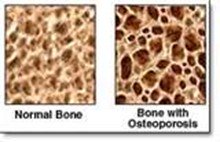|
Dealing With OsteoporosisOsteoporosis is a condition that causes bones to become more porous,gradually making them weaker and more brittle. "Osteo" means bone, and "porosis" means porous. In our growing years the body builds new bone and removes old bone. More bone is built than removed and we grow in size. By the age of about 30 or 40 that process slowly reverses and new growth does not keep up with removal. The rate of bone loss is small and practically unnoticeable in both men and women. However, once women reach menopause the rate of loss speeds up to an average of two percent a year. This is because the onset of menopause reduces the level of estrogen. Estrogen is a hormone which protects the skeleton by helping the body's bone-forming cells to keep working. On a much lower scale the lower testosterone levels in men has a similar effect. 
The most common injury resulting from osteoporosis a is broken hip after a fall. Women are more prone to breaking a hip, 2 to 3 times more often than men. Hip fracture rate doubles every 5 years or so after the age of 50 years. The American Academy of Orthopedic Surgeons reports that white, post-menopausal women have a 1 in 7 chance of fracturing a hip, and that almost half of women who reach the age of 90 years fractured a hip. As many as 20 percent of the people who break their hip because of osteoporosis die within a year. Over age 70, the mortality within a year may increase to as much as 50. Both men and women over fifty can take responsibility for their own bone health by learning and taking steps to prevent or stop loss of bone density. Here are some of the main items to consider. CALCIUM...Bones require calcium and phosphorous for density and growth. However, boosting calcium intake is not a cure-all. Most people with a healthy diet take in enough calcium. It is what happens to it in the body that is the problem. Loss of calcium, or bone mineral, probably results from a combination of genetics and dietary and lifestyle factors, particularly the intake of animal protein, salt, and possibly caffeine, along with tobacco use, physical inactivity, and lack of sun exposure. Animal protein tends to leach calcium from the bones, leading to its excretion in the urine. Also, active people keep calcium in their bones, while sedentary people tend to lose calcium. Cut back on soda pop, refined foods, animal protein and eat more fruits and vegetables. If you don't consume much dairy products, the best source of calcium, you may need a supplement. VITAMIN D...This remarkable vitamin promotes the absorption of calcium and phosphorus. It regulates how much calcium remains in your blood and how much is deposited in bones and teeth. Here are some startling conclusions from one study. Of 1,536 osteoporotic women treated at 61 clinical centers, 62.5% were receiving less than 400 IU of vitamin D, which is the current recommendation for daily supplementation. The ignorance concerning this valuable vitamin is astonishing. About 59% of women reported that their physicians have never discussed vitamin D supplementation with them. You can't get too much Vitamin D if you get it from it's main source, sunshine. EXERCISE...Even if you already have osteoporosis, exercise can delay and possibly reverse it. The best exercises for building bone are weight- or load-bearing exercises. These include weight-lifting, jogging, hiking, stair-climbing, step aerobics, dancing, racquet sports, and other activities that require your muscles to work against gravity. Thirty minutes of weight-bearing exercise daily is an excellent routine. They don't need to be done all at once; it's just as good for you to do 10 minutes at a time. More benefits of exercise:
It's important to chose an exercise program that is safe and comfortable and suits your needs. Thirty minutes daily is best but ten or twenty minutes is much better than none. BMD TEST...The BMD, bone mineral density test,(also known as a bone density test), is one of the most accurate ways to assess your bone health.
Preventing and controlling osteoporosis requires making some changes in diet and lifestyle, getting a lot of the right kind of exercise, and keeping a positive healthy outlook on life. Nothing is more important than feeling good. Return from Osteroporosis to Bones, Joints
|





